Around the Neighborhood - Volume 2, Number 3
In 1973, Family Communications initiated a print newsletter titled Around the Neighborhood. This newspaper-like publication was largely directed towards parents but included some material for children as well. The information below documents the third issue from Volume 2 of Around the Neighborhood.
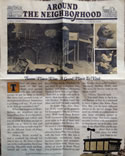
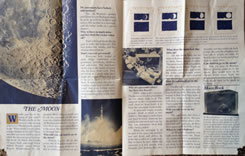
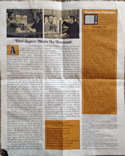
[click images for larger view]
Articles Included:
- Some Place Else: A Good Place to Visit
- The Moon
- Moon Rock
- "The Moon Can Look Different"
- Fred Rogers Meets an Astronaut
- Oceans
- Neighborhood Highlights
Articles
SOME PLACE ELSE: A GOOD PLACE TO VISIT
There are times you want to run and shout, slop around with glue and paper scraps, or just be alone to think. But there isn't enough room, or the right kind of room. Sometimes a grownup will say, "If you want to do that, go someplace else!"
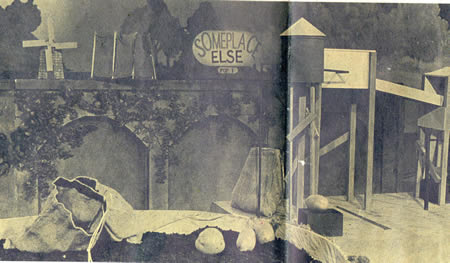
When that happens in Make-Believe, the neighbors can go Some Place Else. It is a big place, with mountains and valleys and lots of room. It is close enough so people can go there to visit and play. But it is far enough away for all the different kinds of things they want to do.
Donkey Hodie wanted to find a windmill big enough for him to live in. He tried to build one in the castle garden, but it was too big. The arms stuck out from behind the castle. That made King Friday angry. "Heehaw, I'll just have to go someplace else, hawhee," said Donkey. Henrietta Pussycat knew how to get there. "Turn left at meow and right at meow, then meow at meow," she told Donkey. Donkey found the place and built his new windmill.
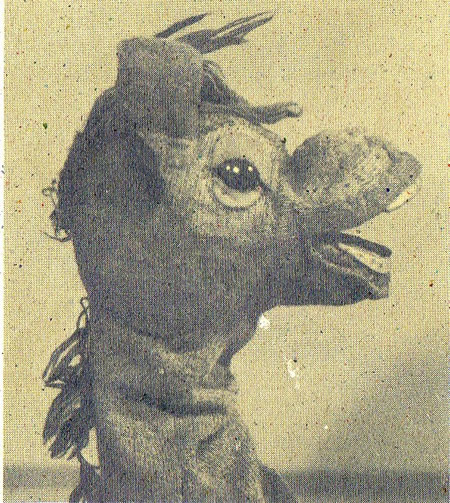
In Some Place Else, Donkey Hodie could grow potatoes for Grandpere's famous pommes frites. With music from Robert Troll's harmonica, the vegetables grew right in front of their very eyes so quickly that Donkey Hodie needed a fulltime helper.
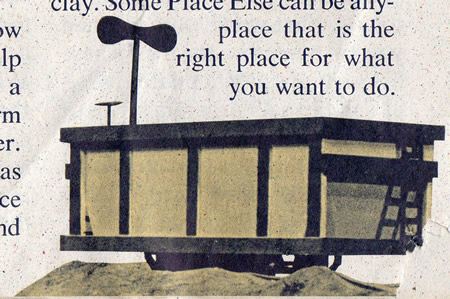
So Harriet Elizabeth Cow arrived in Some Place Else to help with the farm work. She was a bookkeeper, accountant, farm machine expert, and treasurer. She loved farm work. There was plenty of room in Some Place Else to build the Potato Train and the Washer-dryer-sorter-dumper. "Heehaw," Donkey Hodie said. "We have the busiest farm in the whole world."
"I'll say," Harriet said.
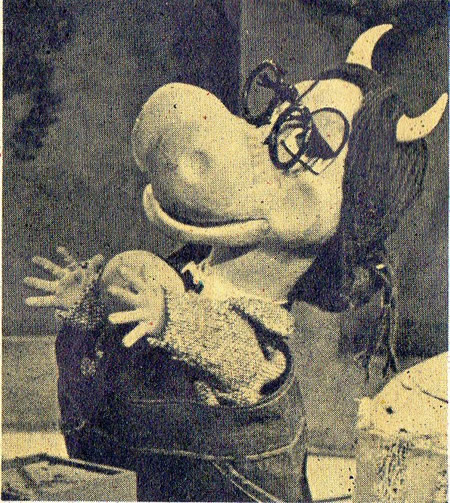
You don't have to be a potato farmer or live in a windmill to have a place like Some Place Else. But you do need different places to do special things. You need an outside or a playroom to play large swooping games or shouting songs. You need a kitchen table covered with newspapers to fingerpaint on or to play with clay. Some Place Else can be anyplace that is the right place for what you want to do.
Would you fly to the moon if you could? Would you fly to the moon if someone said you had to? Would you be scared to go? What would you do when you got hungry on the trip? These are some questions children asked about the space program's trips to the moon. So before the Apollo 15 space flight, astronaut Major Alfred Worden visited Mister Rogers' Neighborhood to talk about it. Mister Rogers made sure to ask the astronaut all the questions the children had asked, and Al Worden promised to try to answer those questions when he got to the moon. Here are the answers he brought back.
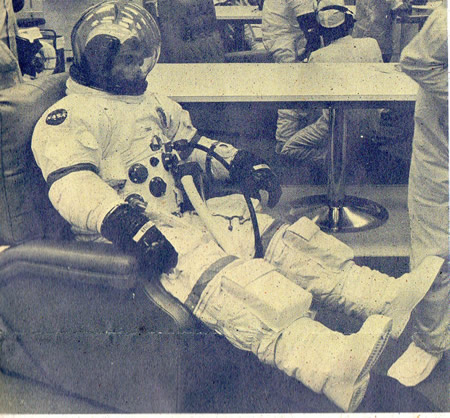
Who told you you had to go to the moon?
Nobody has to fly to the moon, but Al Worden wanted to. He joined the space program so that he would get a chance to go.
Do astronauts have fathers and mothers?
Yes. Al Worden's mother and father live in Michigan where he grew up with his brothers and sisters. His mother is a secretary and his father works in a movie theatre.
Why is there so much noise and fire when the rocket takes off?
Fuel is burned inside the engine to make the rocket go. The fuel makes fire, smoke, and lots of noise when it burns.
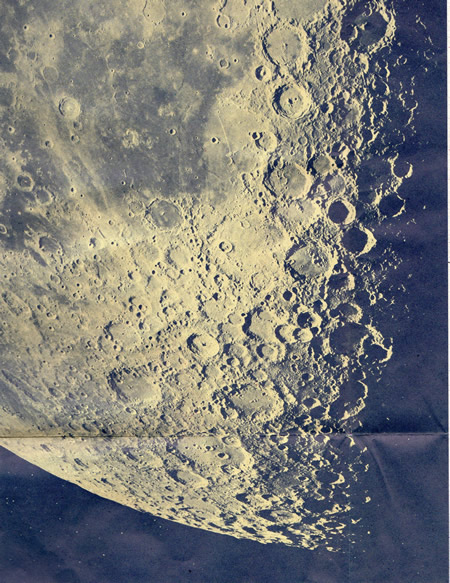
Don't you ever get scared?
Everyone feels scared of some things sometimes, even grownups, presidents, mothers, and astronauts. The astronauts on the way to the moon are going very far away from earth. They are riding in a small, tight place inside the rocket. When they get to the moon, there is no one else there. It makes sense that the astronauts would feel scared sometimes! But even feeling scared isn't enough to stop people from doing something they really want to do.
Why are spacesuits white? Are they very heavy?
White helps keep you cool. The moon is a very hot place when the sun shines right on it. The spacesuit is also air-conditioned; cool, clean air flows inside it to keep the astronaut comfortable.
A spacesuit weighs seventy pounds, about as much as two children. The zipper is in the back and hard to reach. Someone has to help the astronauts put it on, the way you sometimes need help with a heavy jacket.
When the astronaut is all dressed in his space suit and helmet and boots and gloves, he looks like a robot or a superman. But we know he isn't. Inside the spacesuit is a real person, with thoughts and feelings like ours.
What does the moon look like close up?
On the moon there are no trees or flowers, no bugs, no mice, no birds, buses, jungles or cities. The moon made Al Worden think of a huge sandy desert. There are mountains and rocks, and many big holes called craters where smaller space rocks have crashed into the moon.
How do astronauts go to the potty?
On the way to the moon, astronauts go to the potty just the way we do on earth. The only difference is that when they make a BM, they bring it back to earth with them in a sealed plastic bag. That's easier than trying to throw something out of a rocket.
Will you ride a car on the moon?
The astronauts did drive a car on the moon. Because the moon is a bumpy place without roads and highways, Al Worden's space car looked like a Jeep.
Where is your telephone?
Al Worden's telephone was right inside his space suit. There are earphones and a mouthpiece right inside his helmet so that everything he said could be heard by men in the flight control room on earth, and they could talk back to him. Because the telephones let him talk to people on earth, Al Worden felt less lonely and afraid than he might have.
Can children go to the moon?
Not yet, says Al Worden. Before children could go to the moon, they would have to be trained about space flight, the moon, and how to live on it. Space suits would have to be made to fit them.
Al Worden brings a rock to the Neighborhood all the way from the moon! Everyone has to take special care of it. Since scientists study moon rocks to find out what the moon is made of, they wan to be sure that no air or dust or dirt from the earth gets on them. So the rock is kept in a vacuum-sealed container that no one except the scientists must open. So there is no way to get your hands on that piece of moon rock. "Now I know again how children feel," Mister Rogers says, "when people say, 'Don't touch!'"
Sometimes when you look out your window at night, the moon looks like this.
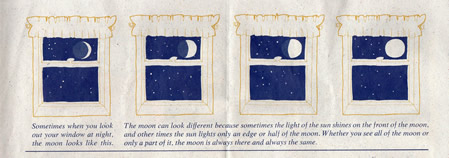
The moon can look different because sometimes the light of the sun shines on the front of the moon, and other times the sun lights only an edge or half of the moon. Whether you see all of the moon or only a part of it, the moon is always there and always the same.
FRED ROGERS MEETS AN ASTRONAUT
At the Cape Kennedy Space Flight Center, a standard safety rule is that no one is allowed very near the launch area. Astronaut Major Al Worden thought that young children would like to know more, in words they understood, about what happens when a moon rocket is launched. He wondered if maybe television would make a good window into a busy, exciting and complex event.
Then one night Al Worden was watching Mr. Rogers' Neighborhood at the home of a Houston friend whose two children watched the program each evening. On this program, Mr. Rogers found one of his goldfish dead, and talked about some of the feelings and responses children have to death. Major Worden was deeply impressed with Fred Rogers' sensitivity to what children are aware of and the way he handled a strong emotional subject. He called Fred Rogers that night and volunteered to be on his program if Fred wanted him to. Fred Rogers agreed at once, and the episode of an astronaut's visit to the neighborhood went into planning.
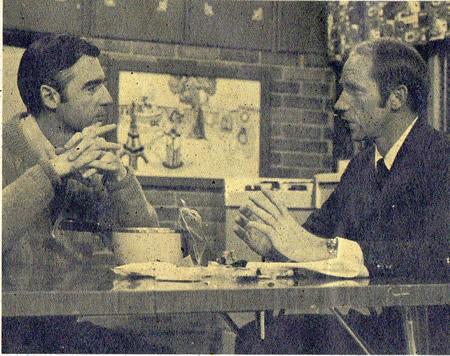
At first, two programs were scheduled. Al Worden and Fred Rogers talked and planned at dinner the evening before the taping and at breakfast. Major Worden still remembers the sense of understanding and rapport between them. The next day when taping began, so much material of interest was generated that the tapings were eventually produced as a half-hour special. Al Worden enjoyed hearing and responding to the questions children had asked Fred Rogers about the moon and space flight, and he even volunteered to take the list of questions with him when he went to the moon -- which he did.
Parents watching Al Worden discuss the complexities of space flight in simple, clear terms were amazed and pleased with the intuition Major Worden showed towards children. He feels that he understands children because he was born second oldest in a family of six and has had two daughters of his own. "I'm much more sensitive to humanistics than to the hardware of life," he added. Choosing the Air Force as a career meant he had little time to spare for humanistics. But during the three days he spent alone in the command capsule while his companions moonwalked, and despite the continual radio contact, he had much thinking time. Some of his thoughts turned into poems. When he returned to earth he wrote them down. He still writes occasionally, and a book of poems will be published soon by Nash. A book of conversations with school children taped during a speaking tour will be issued by Doubleday.
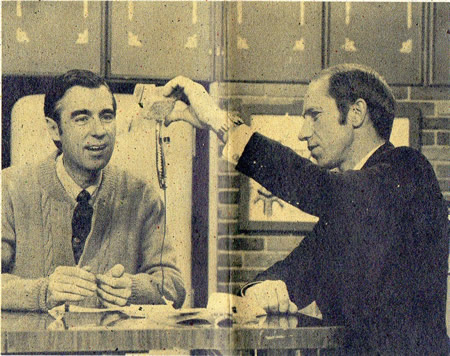
Major Worden works now in the Advanced Concepts division of NASA, on future transportational needs. But the project which most deeply interests him is a series of television documentaries he would like to make on the lives of children in other countries. The project will go ahead, he says, on one condition -- that Fred Rogers be a part of it. "I detest the high-power approach to forming children's minds," says Major Worden simply. "Reading and math are good memory things, but more than that is needed."
OCEANS (by Major Alfred Worden)
The ocean forms a solid line
Where water meets the sky
I sense that I could touch it
If I could only fly.
Pelicans glide in single file
While wind whispers through the grass
The world is calm and peaceful
As waves swing slowly past.
Note: If you miss a program that you or your child is particularly interested in, check with your local station to see when it will be repeated. Give them the program number.
Week of June 2
Suzie Linn and her puppets visit Mister Rogers (#336). In Make-Believe, King Friday commands everyone to watch the TV programs he chooses (#338) and the neighbors protest.
Week of June 10
X the Owl is jealous of a bell Henrietta Pussycat receives for work she has done for King Friday, and in #344, the King gives X some special work to do. Mr. Rogers shows homemade musical instruments.
Week of June 17
A penniless magician is helped by the neighbors of Make-Believe (#346). Mr. Rogers shows play dough you can make (#350).
Week of June 24
Lady Elaine tries to get attention by pretending to discover gold (#351). Mr. Rogers talks about growing tomatoes; Bob Trow shows a beehive (#354). Daniel is afraid of Bob Dog's loud bark (#355).
Week of July 8
Mr. Rogers shows how to make a tree rubbing (#361). Lady Elaine flies to Jupiter on a leaf-mat rocket ship (#363).
Week of July 15
In #367, she announces her great discovery -- Planet Purple. Mr. Rogers plays homemade rhythms (#369) with wood blocks, pie pans and spoons.
Week of July 22
Chef Brockett makes snow pudding (#371). Lady Elaine makes colored snow (#373). Mr. Rogers builds a fire in the fireplace (#373). On Friday (#375) the Snow Opera is performed.
Week of July 29
Cousin Mary Owl visits the neighborhood (#376). John Costa and his grandson visit Francois Clemmons' shop (#379). The Browns show some of their puppets (#380).
Week of August 5
Ezra Jack Keats tells about his book, Apartment Three (#381). Mrs. McFeely rides a motorcycle (#383). In #384 Betty Aberlin has a new camera. Lady Elaine turns the entire neighborhood purple (#383).
Week of August 12
In #388, Mr. Rogers shows a film on how sneakers are made, and a water ballet is performed in Make-Believe. The McFeelys have two lion cubs (#389).
Week of August 19
Chef Brockett tries on a Santa Claus suit (#391). Lady Elaine wants to "be a real barber and cut people's hair and noses and ears" -- Mr. Rogers explains that barbers cut only hair (#392). In #395, Chef Brockett opens his soda fountain.
Week of August 26
Henrietta is hurt when Colette sends her some hand-me-down clothes (#396). In #397, Elsie Neal shows how to make hats, and in #399, Bob Trow's son Rob performs with his own musical group.
Credits
Around the Neighborhood and the materials that accompany it are published ten times a year by Family Communications, Inc., a not-for-profit Pennsylvania corporation. Mister Rogers' Neighborhood is funded by public television stations, the Ford Foundation, the Corporation for Public Broadcasting, Sears Roebuck Foundation, and Johnson & Johnson Baby Products Company.
Around the Neighborhood is created in association with Media Projects Incorporated of New York. Subscriptions, printing, and distribution are accomplished by Multiscope, Inc., Pittsburgh, Pa.
Executive Editor: Sara Stein
Editor: Barbara Staib
Editorial Consultant: Hedda Sharapan
Psychological Consultant: Dr. Margaret McFarland
Graphic Designer: Tobias O'Mara
© 1974, Family Communications Inc.
